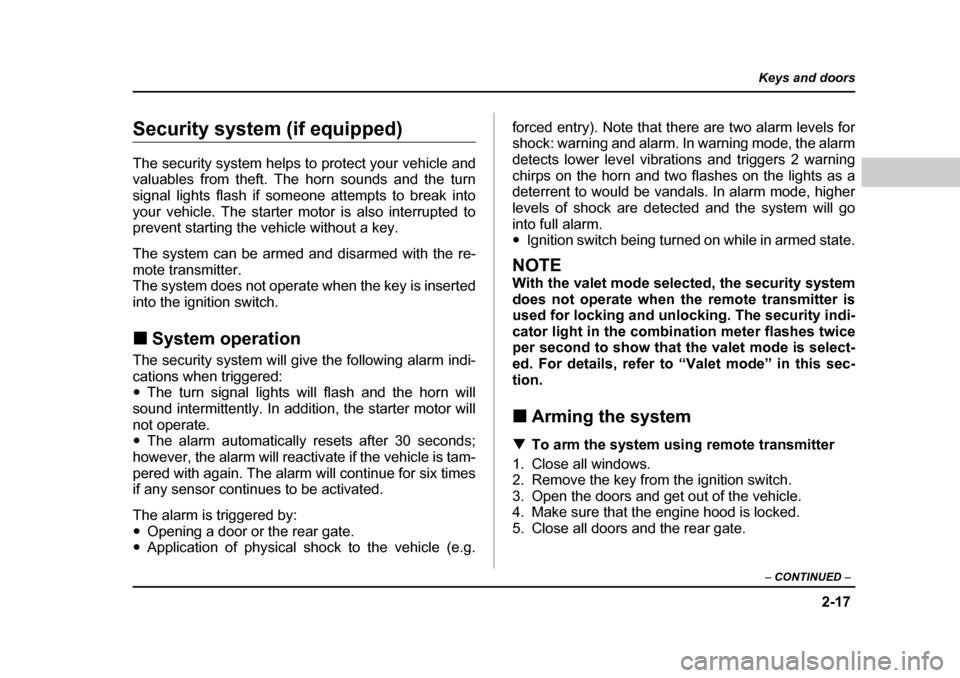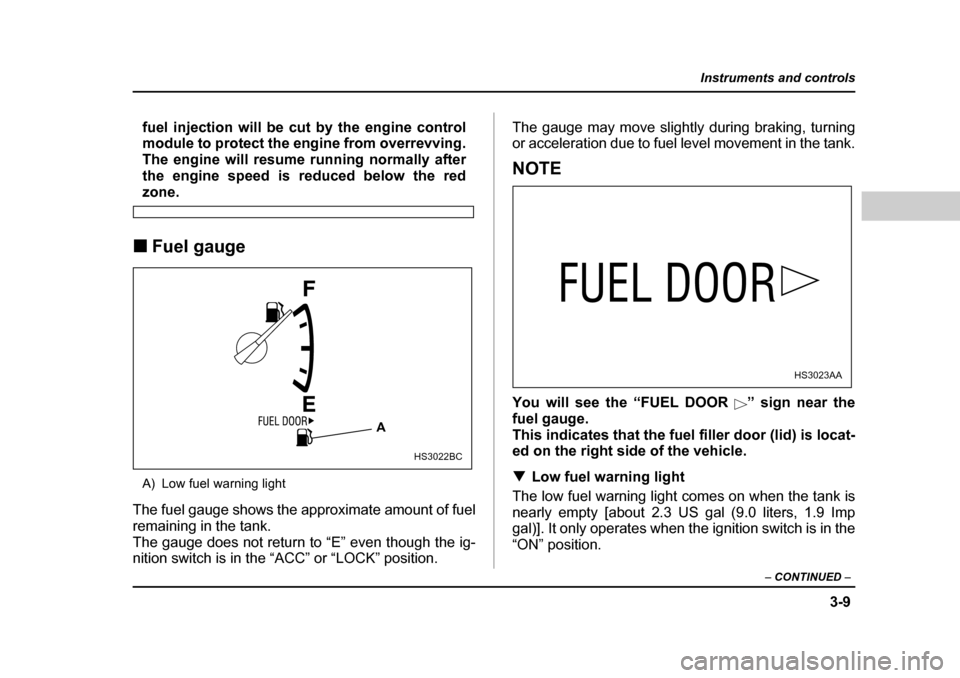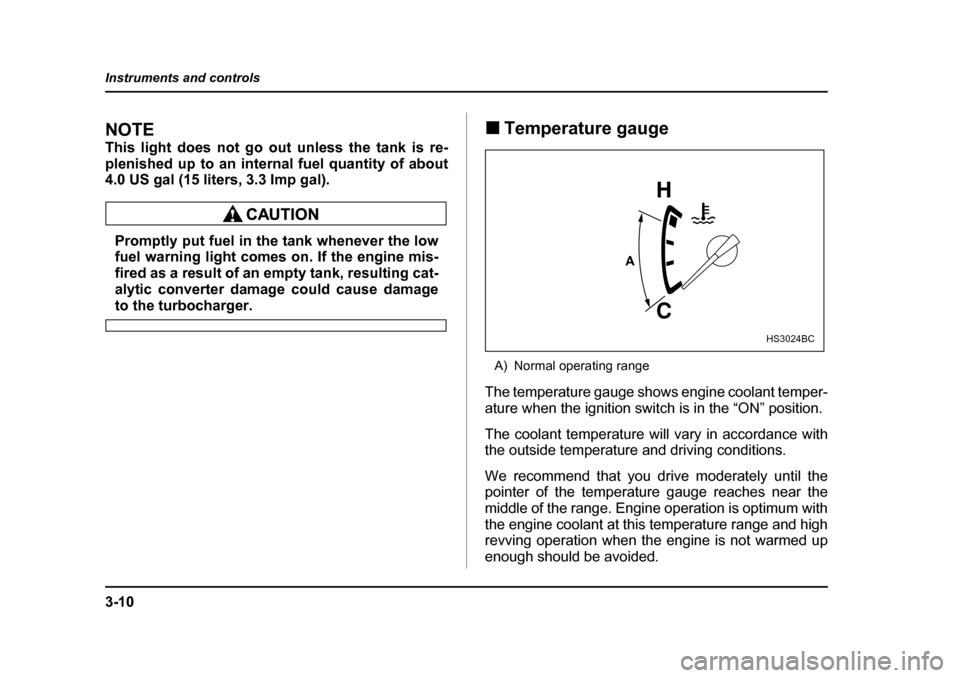2005 SUBARU FORESTER warning light
[x] Cancel search: warning lightPage 128 of 477

2-17
Keys and doors
– CONTINUED –
Security system (if equipped)
The security system helps to protect your vehicle and
valuables from theft. The horn sounds and the turn
signal lights flash if someone attempts to break into
your vehicle. The starter motor is also interrupted to
prevent starting the vehicle without a key.
The system can be armed and disarmed with the re-
mote transmitter.
The system does not operate when the key is inserted
into the ignition switch. �„System operation
The security system will give the following alarm indi-
cations when triggered: �y The turn signal lights will flash and the horn will
sound intermittently. In addition, the starter motor will
not operate. �y The alarm automatically resets after 30 seconds;
however, the alarm will reactivate if the vehicle is tam-
pered with again. The alarm will continue for six times
if any sensor continues to be activated.
The alarm is triggered by: �y Opening a door or the rear gate.
�y Application of physical shock to the vehicle (e.g. forced entry). Note that there are two alarm levels for
shock: warning and alarm. In warning mode, the alarm
detects lower level vibrations and triggers 2 warning
chirps on the horn and two flashes on the lights as a
deterrent to would be vandals. In alarm mode, higher
levels of shock are detected and the system will go into full alarm. �y
Ignition switch being turned on while in armed state.
NOTE
With the valet mode selected, the security system
does not operate when the remote transmitter is
used for locking and unlocking. The security indi-
cator light in the combination meter flashes twice
per second to show that the valet mode is select-
ed. For details, refer to “Valet mode” in this sec- tion. �„ Arming the system
�T To arm the system using remote transmitter
1. Close all windows.
2. Remove the key from the ignition switch.
3. Open the doors and get out of the vehicle.
4. Make sure that the engine hood is locked.
5. Close all doors and the rear gate.
Page 142 of 477

3-1
3
Instruments and controls
Ignition switch .............................................. 3-3 LOCK .................................................................. 3-3
ACC .................................................................... 3-4
ON ....................................................................... 3-4
START ................................................................ 3-4
Key reminder chime .......................................... 3-5
Ignition switch light (if equipped) .................... 3-5
Key interlock release (AT vehicles only) ........ 3-6
Hazard warning flasher ................................ 3-7
Meters and gauges ....................................... 3-7 Speedometer ..................................................... 3-7
Odometer/Trip meter ........................................ 3-7
Tachometer ........................................................ 3-8
Fuel gauge ......................................................... 3-9
Temperature gauge ........................................... 3-10
Outside temperature indicator ......................... 3-11
Warning and indicator lights ....................... 3-12 Seatbelt warning light and chime .................... 3-13
SRS airbag system warning light .................... 3-13
CHECK ENGINE warning light/Malfunction indicator lamp ................................................. 3-13
Charge warning light ........................................ 3-14
Oil pressure warning light ................................ 3-15
AT OIL TEMPerature warning light
(AT vehicles) ................................................... 3-15
ABS warning light ............................................. 3-15
Vehicle Dynamics Control warning light (if equipped)/Vehicle Dynamics Control
OFF indicator light (if equipped) ................... 3-16
Brake system warning light ............................. 3-18
Door open warning lights ................................. 3-19 Low fuel warning light ...................................... 3-19
All-Wheel Drive warning light (AT vehicles) ... 3-19
Vehicle Dynamics Control operation
indicator light (if equipped) ........................... 3-20
Shift position indicator (AT vehicles) ............. 3-20
Turn signal indicator lights .............................. 3-21
High beam indicator light ................................. 3-21
Cruise control indicator light (if equipped) .... 3-21
Cruise control set indicator light (if equipped) .................................................... 3-21
Clock .............................................................. 3-22
Light control switch ...................................... 3-23 Headlights ......................................................... 3-23
High/low beam change (dimmer) .................... 3-24
Headlight flasher ............................................... 3-24
Daytime running light system ......................... 3-25
Turn signal lever ........................................... 3-25
Illumination brightness control ................... 3-26
Parking light switch ...................................... 3-27
Fog light button (if equipped) ...................... 3-27
Wiper and washer ......................................... 3-28 Windshield wiper and washer switches ......... 3-29
Rear window wiper and washer switch .......... 3-31
Windshield wiper deicer (if equipped) ........ 3-32
Rear window defogger button ..................... 3-33
Mirrors ............................................................ 3-35 Inside mirror ...................................................... 3-35
Outside mirrors ................................................. 3-37
Tilt steering wheel ......................................... 3-39
Page 150 of 477

3-9
Instruments and controls
– CONTINUED –
fuel injection will be cut by the engine control
module to protect the engine from overrevving.
The engine will resume running normally after
the engine speed is reduced below the red
zone.
�„ Fuel gauge
A) Low fuel warning light
The fuel gauge shows the approximate amount of fuel
remaining in the tank.
The gauge does not return to “E” even though the ig-
nition switch is in the “ACC” or “LOCK” position. The gauge may move slightly during braking, turning
or acceleration due to fuel level movement in the tank.
NOTE
You will see the “FUEL DOOR ” sign near the
fuel gauge.
This indicates that the fuel filler door (lid) is locat-
ed on the right side of the vehicle. �T
Low fuel warning light
The low fuel warning light comes on when the tank is
nearly empty [about 2.3 US gal (9.0 liters, 1.9 Imp
gal)]. It only operates when the ignition switch is in the
“ON” position.
A
HS3022BC
HS3023AA
Page 151 of 477

3-10
Instruments and controls
NOTE
This light does not go out unless the tank is re-
plenished up to an internal fuel quantity of about
4.0 US gal (15 liters, 3.3 Imp gal).
Promptly put fuel in the tank whenever the low
fuel warning light comes on. If the engine mis-
fired as a result of an empty tank, resulting cat-
alytic converter damage could cause damage
to the turbocharger.
�„
Temperature gauge
A) Normal operating range
The temperature gauge shows engine coolant temper-
ature when the ignition switch is in the “ON” position.
The coolant temperature will vary in accordance with
the outside temperature and driving conditions.
We recommend that you drive moderately until the
pointer of the temperature gauge reaches near the
middle of the range. Engine operation is optimum with
the engine coolant at this temperature range and high
revving operation when the engine is not warmed up
enough should be avoided.
A
HS3024BC
Page 153 of 477

3-12
Instruments and controls
�y
When the actual outside temperature falls outside
the specified indicator range.Warning and indicator lights
Several of the warning and indicator lights come on
momentarily and then go out when the ignition switch
is initially turned to the “ON” position. This permits
checking the operation of the bulbs.
Apply the parking brake and turn the ignition switch to
the “ON” position. The following lights come on:
Seatbelt warning light
SRS airbag system warning light
CHECK ENGINE warning light/Malfunction indica- tor lamp
Charge warning light
Oil pressure warning light
AT OIL temperature warning light (AT vehicles) ABS warning light
Vehicle Dynamics Control warning light (if
equipped)/Vehicle Dynamics Control OFF indicator
light (if equipped) Brake system warning light
All-Wheel Drive warning light (AT vehicles)
Vehicle Dynamics Control operation indicator light
(if equipped)
Cruise control indicator light (if equipped)
Cruise control set indicator light (if equipped)
If any lights fail to come on, it indicates a burned-out
Page 154 of 477

3-13
Instruments and controls
– CONTINUED –
bulb or a malfunction of the corresponding system.
Consult your authorized SUBARU dealer for repair. �„Seatbelt warning light and chime
When the ignition switch is turned to the “ON” position,
the seatbelt warning light will come on and the remind-
er chime will sound for about six seconds to remind the
driver to fasten the seatbelt.
The seatbelt warning light will turn off when the driv-
er’s side seatbelt is buckled.
The seatbelt reminder chime will turn off when the
driver’s side seatbelt is buckled or it will turn off auto-
matically after six seconds. �„ SRS airbag system warning light
When the ignition switch is turned to the “ON” position,
the SRS airbag system warning light will come on for
about six seconds and go out. This shows the SRS air-
bag and SRS side airbag (if equipped) and seatbelt
pretensioners are in normal operation.
If the warning light exhibits any of the following
conditions, there may be a malfunction in the
seatbelt pretensioners and/or SRS airbag sys- tem. Immediately take your vehicle to your
nearest SUBARU dealer to have the system
checked. Unless checked and properly re-
paired, the seatbelt pretensioners and/or SRS
airbags will operate improperly (e.g. SRS air-
bags may inflate in a very minor collision or not
inflate in a severe collision), which may in-
crease the risk of injury.�y
Flashing or flickering of the indicator light
�y No illumination of the warning light when the
ignition switch is first turned to the “ON” posi-tion �y Continuous illumination of the warning light
�yIllumination of the warning light while driving
�„ CHECK ENGINE warning light/
Malfunction indicator lamp
If the CHECK ENGINE light comes on while you
are driving, have your vehicle checked/repaired
by your SUBARU dealer as soon as possible.
Continued vehicle operation without having the
emission control system checked and repaired
as necessary could cause serious damage,
Page 155 of 477

3-14
Instruments and controls
which may not be covered by your vehicle’s
warranty.
If this light comes on steadily or blinks while the engine
is running, it may indicate that there is a problem or po-
tential problem somewhere in the emission control
system. �T If the light comes on steadily:
If the light comes on steadily while driving or does not
go out after the engine starts, an emission control sys-
tem malfunction has been detected.
You should have your vehicle checked by an autho-
rized SUBARU dealer immediately.
NOTE
This light also comes on when the fuel filler cap is
not tightened until it clicks.
If you have recently refueled your vehicle, the cause of
the CHECK ENGINE warning light/malfunction indica-
tor lamp coming on could be a loose or missing fuel fill-
er cap. Remove the cap and retighten it until it clicks.
Make sure nothing is interfering with the sealing of the
cap. Tightening the cap will not make the CHECK EN-
GINE warning light turn off immediately. It may take
several driving trips. If the light does not go out, take
your vehicle to your authorized SUBARU dealer im- mediately. �T
If the light is blinking:
If the light is blinking while driving, an engine misfire
condition has been detected which may damage the
emission control system.
To prevent serious damage to the emission control
system, you should do the following: �y Reduce vehicle speed.
�y Avoid hard acceleration.
�y Avoid steep uphill grades.
�y Reduce the amount of cargo, if possible.
�y Stop towing a trailer as soon as possible.
The CHECK ENGINE warning light may stop blinking
and come on steadily after several driving trips. You
should have your vehicle checked by an authorized
SUBARU dealer immediately. �„ Charge warning light
If this light comes on when the engine is running, it
may indicate that the charging system is not working
properly.
If the light comes on while driving or does not go out
after the engine starts, stop the engine at the first safe
opportunity and check the alternator belt. If the belt is
loose, broken or if the belt is in good condition but the
Page 156 of 477

3-15
Instruments and controls
– CONTINUED –
light remains on, contact your nearest SUBARU deal-
er immediately. �„Oil pressure warning light
If this light comes on when the engine is running, it
may indicate that the engine oil pressure is low and the
lubricating system is not working properly.
If the light comes on while driving or does not go out
after the engine starts, stop the engine at the first safe
opportunity and check the engine oil level. If the oil lev-
el is low, add oil immediately. If the engine oil is at the
proper level but the light remains on, contact your
nearest SUBARU dealer immediately.
Do not operate the engine with the oil pressure
warning light on. This may cause serious en-
gine damage.
�„ AT OIL TEMPerature warning
light (AT vehicles)
The AT oil temperature warning light comes on when
the ignition switch is turned to the “ON” position and
goes out after about two seconds. If this light comes on when the engine is running, it
may indicate that the automatic transmission fluid tem-
perature is too hot.
If the light comes on while driving, it is unnecessary to
stop the vehicle, but avoid driving up steep grades or
in stop and go traffic. �T
Automatic transmission control system warn-
ing
If the light flashes after the engine starts, it may indi-
cate that the automatic transmission control system is
not working properly. Contact your nearest SUBARU
dealer for service immediately. �„ ABS warning light
The ABS warning light comes on when the ignition
switch is turned to the “ON” position and goes out after
about two seconds.
This is an indication that the ABS system is working
properly.
If the warning light behaves as follows, the ABS
system may not work properly.
When the warning light is on, the ABS function
shuts down; however, the conventional brake
(U.S.) (Canada)